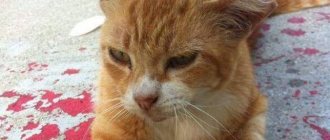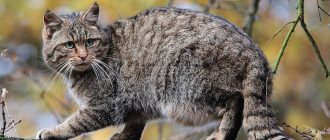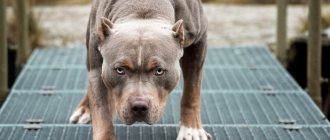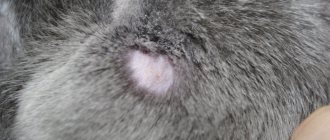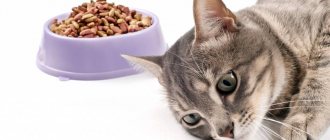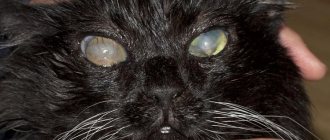Unfortunately, our pets are also susceptible to various diseases, in particular, pathologies of the gastrointestinal tract. Some diseases in them may acquire varying degrees of severity, and be accompanied by clinical manifestations that characterize them. For example, one of the signs of serious digestive ailments is black feces in a cat, indicating that the disease is taking an unpleasant turn. The faster you respond to this symptom, the less severe the consequences will be. We will consider what this manifestation may mean in this article.
Black feces in a cat can be a symptom of some very unpleasant and dangerous illness.
What should a cat's poop look like normally?
For timely diagnosis of the disease, it is important to know the pet’s health parameters when its condition is normal. The same rule applies to feces. In a healthy pet, the color of feces should be brown, and different shades are allowed - from light brown to dark brown. The consistency should be dense, well-formed, without crumbling. The smell of healthy cat feces is specific, but not pungent.
You can understand that something is bothering your cat by observing its behavior. Anxiety or apathy is a reason to visit the veterinarian.
An example of how easy it is to identify a disease by observing a cat can even be its feces. For example, hard and dry feces indicate stagnation of contents in the distal colon. Excrement in the form of small lumps usually appears when there is a lack of fluid, especially when eating exclusively dry food (less often with spastic colitis). Wet feces that do not hold their shape well are evidence of increased gastrointestinal motility due to an excess of fiber. Pasty, shapeless feces mean that the cat has infectious processes or intoxication in its body. Liquid, watery stool with solid inclusions is a sign of severe poisoning, increased intestinal contractility or acute intestinal infection. Well, the ribbon-like form occurs as a result of the formation of hemorrhoids, trauma to the anus, sphincter spasms or neoplasms in the rectum. Using this example, it is easy to determine the important role played by the owner’s attentive attitude towards his pet, in monitoring its behavior and external condition.
What to feed a cat during diarrhea
Note that in the first day after the onset of diarrhea, the pet should be put on a starvation diet, without restricting water. Such a “fast” is needed so that during the rest period the animal’s digestive system returns to normal.
Remember that serving fatty or heavy food at this time is almost 100% guaranteed to provoke a new attack of diarrhea, worsening the cat’s already not “brilliant” condition.
But still, what should you feed your pet so as not to burden its gastrointestinal tract, but at the same time not starve it? Even among experienced veterinarians and breeders there are many opinions on this matter, but the “average optimal value” can be deduced from their recommendations:
- Boiled rice. It is best to use round varieties, boiling the product to a semi-liquid pulp. This consistency has a positive effect on the condition of the long-suffering intestinal mucosa without further irritating it. The pet should be fed this for the first day or two.
- Chicken bouillon. The better the cat becomes, the more saturated broths can be used. We warn you once again that at first it is extremely undesirable to use fatty foods, as they will almost certainly cause a violent relapse of diarrhea.
- Boiled chicken. It is advisable to use the breast as the least fatty part. It is necessary to constantly monitor the cat’s well-being and, if signs of stool liquefaction appear, reduce the amount of meat in its food.
- High-quality low-fat offal. But this must be done as carefully as possible, starting from the first week after the last attack of diarrhea.
- Finally, to relieve bouts of diarrhea, you can use pumpkin puree from baby food. The dose is approximately half a teaspoon at a time. The duration of submission is approximately three days.
Causes of black feces in cats
It is worth taking your cat to the doctor if he has had black feces for several days.
In order to understand what caused black feces in a cat, you must first analyze the diet of the animal that preceded this phenomenon, as well as its duration. If this is a one-time occurrence, there is no need to worry. But in the case when a cat’s stool takes on this color for a long time, it’s worth moving on to identifying the reasons. They can be physiological and pathological.
Physiological reasons
If there is a physiological reason, it is enough to remove the irritant from the diet, but it is important to prevent such situations from reoccurring.
If outwardly everything is fine with the pet, he is not lethargic, plays actively and, in principle, his appearance does not cause concern, the reason may be a large amount of meat that has not undergone heat treatment and was eaten by your cat (for a kitten, for a change in the color of the feces and even a small piece is enough), consuming large amounts of blood meal with black licorice and giving your pet vitamins, supplements and vitamin complexes containing iron (the side effect of black feces can, in this case, be seen on the packaging these drugs). It may also be the case in products containing colored pigments (this can be observed, for example, after consuming activated carbon). In all these cases, no intervention is required other than eliminating inappropriate foods from the diet.
It is important to prevent such situations from reoccurring, because your pet may suffer, in this case, from protein overfeeding, dietary fiber deficiency, or infection with microbes and parasites.
Pathological causes
Small gray kitten in blue plastic litter cat on wooden table on window background
In some cases, the reason why your cat has black stool may be due to pathology. Its symptom is melena - black, semi-liquid stool, accompanied by an unpleasant odor. In such cases, blood gives the black color to the stool. Such feces may be a symptom of the following diseases:
- Gastroenteritis in hemorrhagic form. Its cause may be complications of severe bacterial and viral diseases, absolute intolerance to certain foods, allergies, dysfunction of the coagulation system, or autoimmune pathology. During the manifestation of this pathology, the epithelium of part of the intestine and the gastric mucosa exfoliates and injures small blood vessels, resulting in blood appearing in the stool.
- Gastritis, ulcerative enterocolitis, ulcer (stomach or duodenum). Blood in the stool in the presence of these diseases appears as a result of bleeding ulcers.
- Postoperative hemorrhage (often observed after operations on the gastrointestinal tract).
- Worm infestation. Bleeding can occur due to parasites that attach to the intestinal mucous membranes and injure them.
- Inflammation of the stomach or small intestine due to injury. The walls of the gastrointestinal tract can be damaged by foreign objects (such as bones). In particularly severe cases of injury, perforation may occur.
- Neoplasms in the stomach or small intestine. The mucous membrane can be corroded and bleeding ulcers formed as a result of tumors (especially malignant ones).
- Consumption of heavy metals with food (of all the listed pathologies, this is the rarest).
Treatment for black stools
Treatment methods and the use of medications depend on the diagnosis. In general, treatment is carried out as follows:
- Stop bleeding. This is the first priority. Losing a large amount of blood can be fatal. Purr is prescribed hemostatic drugs: “Vikasol”, “Ditsinon”. It is important to follow the dosage prescribed by your doctor, otherwise the risk of blood vessel blockage with blood clots increases.
- Elimination of the cause of the pathology. If a cyst or foreign body is detected in the gastrointestinal tract, surgical intervention is prescribed.
- Deworming. Even if the cause of the bleeding was not parasites, but the infection was discovered through tests, the cat must be given anthelmintic drugs.
- Antibacterial therapy. The purr is prescribed antibiotics, antiviral drugs and immunomodulators if the cause of the pathology is an infectious disease.
- Elimination of ulcers. When ulcers are detected, gastroprotectors are used, for example, Almagel, Phosphalugel.
Table: Effective treatment methods
Therapy will be effective only after identifying the cause of the change in stool. Attempting to treat your pet on your own without medical advice is dangerous for the animal’s life.
Depending on the cause and condition of the cat, he may be prescribed IVs to replenish lost fluid and vitamin injections. However, treatment cannot begin until the bleeding has stopped.
Black stool is not a separate disease, but a symptom of a large number of pathologies, but most often the cause is internal bleeding. In order to provide timely assistance to your pet, you should be attentive to cleaning the litter box, studying the cat's stool, its color, consistency, and the presence of parasite particles in it. Don't panic if your pet's behavior doesn't change.
Recommended Posts
What to do if your cat has blood in the stool: causes, diagnosis and treatment
Causes and treatment options for diarrhea in cats
What to do if your cat has a big belly: causes, treatment and prevention
A cat scratches its neck: possible causes of itching and methods of treatment
Common ear sores in cats: symptoms and treatment methods
Causes of white feces in dogs and other abnormalities
Associated symptoms
If you have certain accompanying symptoms, you must consult a doctor. Delay can cost your pet serious health problems, or even life.
Symptoms that accompany the appearance of black feces in a cat may include black or red vomiting, malaise due to constant blood loss, acute abdominal pain, bleeding from the anus and nausea. These symptoms are signs of serious disorders in the body and require prompt intervention by a doctor.
General information
Diarrhea, or diarrhea, is nothing more than an upset stomach, the main symptom of which is loose stools. A healthy animal's stool is usually well-formed, dark brown in color, and slightly soft and moist. Normally, a cat should go to the toilet 1-2 times a day.
Diarrhea may be accompanied by vomiting, nausea, and your pet may lose its appetite. Often the cat suffers from abdominal pain and experiences severe stress. If measures are not taken in time and treatment of the animal is not started, dehydration will occur in its body, which can even lead to death.
Diagnosis for the appearance of black stool
If you record a list of symptoms and observation results before visiting a doctor, you will significantly speed up and make it easier for him to make a diagnosis.
Before prescribing diagnostic tests, an analysis of the pet’s appearance, the conditions of its maintenance and nutrition, as well as previous diseases is carried out. All this will help determine what the described phenomenon may be associated with. Then, to identify the cause of the disease, the following studies are carried out:
- Blood test (helps assess the condition of internal organs and identify problems with the liver or gall bladder);
- Stool analysis (checks for sand, toxic substances, bones, parasites or inflamed tissue);
- Urinalysis (helps assess the general condition of the body);
- Ultrasound of the abdominal organs (with its help, neoplasms, obstruction of the bile ducts, cysts, fibrous tissue, stones and sand in the gallbladder are detected);
- X-ray (helps detect liver enlargement, cysts and neoplasms);
- Biopsy of affected tissue (detects tumors).
Diagnostics and therapy
So we found out why cats have black diarrhea. If you observe, in addition to the melena itself, the following signs, you should immediately run to the vet:
- Diarrhea.
- Vomit.
- Pale gums.
- Presence of bruising or other areas of bleeding (indicates coagulopathy).
- Weight loss.
- Poor appetite.
- Excessive drinking and “exorbitant” volumes of urine.
To find out the root cause of what is happening to the cat, the veterinarian will resort to various diagnostic techniques, including x-rays, ultrasound, blood and urine tests , as well as other methods. How is the treatment done? Since melena is not a disease, but only its symptom, the primary pathology that directly leads to intestinal bleeding is treated.
But in any case, the veterinarian will first solve the problem of blood loss. Of course, ideally, a sick pet needs a transfusion, but in a veterinary clinic this is almost unrealistic. We do not have blood banks, and targeted blood collection is carried out only in the largest veterinary centers. So blood loss is partially replaced with plasma or even saline. The main thing is to prevent collapse and reduce the load on the body’s blood depots.
Dangerous symptoms requiring urgent attention to a veterinarian
Dangerous symptoms should never be ignored.
You can determine the degree of danger of your pet's health by its behavior and appearance. If you observe at least one of the items on the list below, immediately seek medical help:
- The cat meows and experiences pain and anxiety when you try to touch his stomach.
- Cat stool is a semi-liquid black consistency with a foul odor (called “Melena”).
- The cat is behaving very lethargically. He lies face down and does not react to anything.
- The animal either drinks too much or refuses water altogether.
- Your pet has pale gums.
- There are bloody clots in the stool.
- Body temperature rises above thirty-nine degrees.
- Vomiting or false retching is observed.
- The cat eats less than usual or refuses food altogether.
- Frequent trips to the toilet to empty the bladder.
- The presence of hematomas or wounds on the body.
Symptoms
The most dangerous symptoms in combination with black feces are:
- your pet has a stomach ache;
- there is an increased body temperature;
- diarrhea;
- vomit;
- the cat doesn't eat anything;
- the animal is lethargic;
- there are blood clots in the feces (this indicates bleeding in the gastrointestinal tract).
If a cat exhibits the above conditions, then a veterinary examination is necessary, and an appointment with a doctor must be made as soon as possible.
When a diagnosis is made, liquid black stool is sent for examination. If blood is detected, the cat is examined to identify the causes of this phenomenon. An ultrasound, x-rays, coagulogram, gastroscopy are performed, and blood tests are performed.
Treatment of black feces in cats
As described earlier, first of all, in the presence of blood in the stool, hemostatic drugs are used. Since these drugs are administered intramuscularly or intravenously, treatment is carried out exclusively in a hospital. The principle of application is as follows:
- Diction. This drug is administered intramuscularly. The frequency of injections is twice a day, ten to twelve milligrams of solution is taken per kilogram of the animal’s body weight. Use the drug for three days.
- Tranexam. In this case, the medicine is administered either intravenously or intramuscularly, and this is done every eight hours. Ten to fifteen milligrams of the drug are used per kilogram of body. Treatment is stopped after bleeding has stopped.
- Vikasol 1%. Treatment with this drug lasts for three to five days. Two milligrams of medication are used per kilogram of weight.
- Aminocaproic acid 5%. This medicine is either given to the pet to drink or administered intravenously. In case of injection, use one milligram of the drug per kilogram of weight. In the case when a cat drinks the medicine, there are seven to ten milligrams of the drug per kilogram. The cat needs to take the medicine five times a day.
Animals are treated on an inpatient basis.
After stopping the bleeding, they begin to eliminate the underlying disease. For bacterial pathologies, Amoxicillin, Tetracycline and Gentamicin are used; to protect the gastric mucosa - Almagel, De-Nol and Phosphalugel; to eliminate viruses - Cycloferon, Gamavit and Interferon; to combat worms - Drontal, Dirofen and Pratel.
There is no need to self-medicate - there is a high risk of not helping, but harming your pet. It is best to consult a doctor who will prescribe individual treatment.
What to do for prevention?
Preventive measures involve systematic treatment for worms.
Liquid or dry feces, which are constantly observed in a pet, in any case, are evidence of some kind of internal progressive disorder. To prevent consequences dangerous to the cat’s health and life, it is important to follow preventive rules. First of all, it is important to monitor the cat’s nutrition and provide it with fresh and clean water. Do not forget to carry out preventive anthelmintic treatment. If viral infectious diseases develop, do not self-medicate, but take the animal to a veterinarian, who, based on the diagnostic results, will select an effective treatment. In order for the cat’s body to more actively resist various diseases, it is useful to strengthen the pet’s immunity. To do this, it is recommended to give courses of vitamins and various biologically active supplements, which are selected by the veterinarian, taking into account the individual characteristics of the cat.
Feeding during diarrhea
There is no need to feed the animal on the first day if diarrhea occurs; you just need to stimulate fluid intake and give some kind of enterosorbent. If the diarrhea has stopped, gradually switch the cat to its usual food.
If diarrhea is caused by an allergic reaction, after fasting for a day, you need to switch to a special hypoallergenic food; with natural feeding, give dietary meat - lamb, rabbit or turkey.
We suggest you read: Signs of false pregnancy in pigs. How to determine if a pig is pregnant at home: diagnostic methods. How long can pigs of different breeds stay pregnant and bear piglets?
It is very good to feed an animal with diarrhea rice water, add boiled rice to food, and give egg whites. For food in the first days, wet diets are preferable for dietary nutrition.
